18 Fast-Growing Flower Seeds: With Pictures and Sowing Instructions
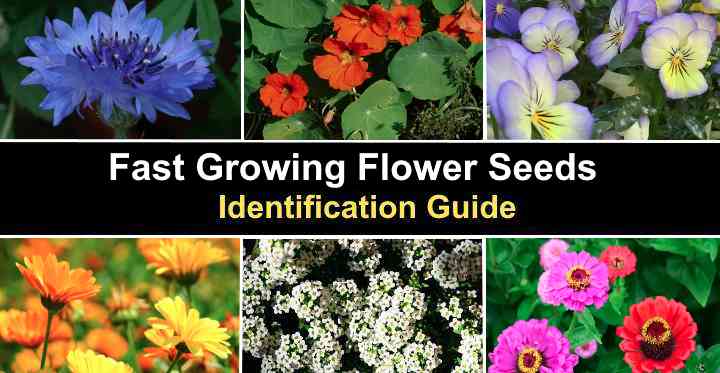
Fast-growing flower seeds are perfect if you want to add color to your garden landscape quickly. Seeds germinating and growing rapidly usually produce flowers a month or two after sowing. This allows you to enhance your spring, summer, and fall garden’s aesthetics with spectacular fast-growing flowers like marigolds, zinnias, sunflowers, cosmos, and morning glories.
Depending on your climate, flowers that grow from seed in three to four weeks may need to start indoors. This is because late frosts can impact seedling growth, and some fast-growing flowers cannot withstand cold temperatures.
This article lists the best fast-growing flower seeds that germinate and flower a few weeks after planting. Descriptions and pictures of the flowers will help you choose the best seeds to sow in early spring to create a vibrant and blooming garden in no time.
What Are Fast-Growing Flower Seeds?
Fast-growing seeds are seeds that germinate quickly and produce flowers in a short time after planting. The seed’s rapid growth makes the fast-blooming flowers ideal for early spring flowers, short growing seasons, or impatient or inexperienced gardeners. Many annuals produce flowers from seed relatively rapidly.
Some of the fastest-growing flower seeds are poppies, petunias, cornflower, sunflowers, and annual phlox. For example, morning glories, poppies, and nasturtiums may produce flowers four to six weeks after germinating. They are also low-maintenance plants that require little care after planting in the ground.
When to Plant Fast-Growing Flower Seeds
Plant fast-growing flower seeds in spring after the last frost date when the soil has warmed. However, you may have to start the seed indoors in colder climates to prevent damage from spring frosts. This provides optimal conditions for quick germination and rapid growth.
The time to plant seeds that grow rapidly depends on the flower type. Here is a quick guide to sowing and growing fast-blooming plants:
Hardy seeds: Sow the seeds directly in the ground, or sow indoors eight to ten weeks before the last frost date. Then, transplant the seedlings to the ground four weeks after any frost risk has passed.
Half-hardy seeds: Sow in the ground outdoors after a threat of hard frost has passed. Alternatively, you can start them indoors six to eight weeks before the last frost date.
Tender seeds: Plant in the ground after the risk of any frost has passed, or start indoors four to six weeks before the last spring frost date.
However, always check seed packets for specific recommendations—timing may vary depending on location and climate. Also, you must know if the seeds are classed as hardy, half-hardy, or tender.
Why Plant Fast-Growing Flowers From Seed
Planting flowering seeds that grow fast allows you to create a vibrant landscape in no time. The colorful blooms add beauty and color to spring and summer landscapes. And, you have a wider variety of blooms, letting you change the front or backyard’s aesthetics year after year.
Fast-growing flowers are also perfect for beginners as they are easy to plant and grow.
Fast Growing Flower Seeds: With Pictures and Sowing Instructions
Let’s look in detail at some of the quickest blooming flowers to grow from seed.
Petunias (Petunia)
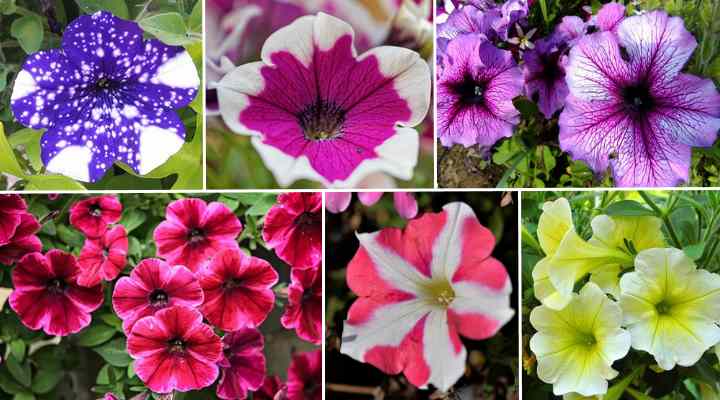
Petunias are the easiest and fastest flowers to grow from seed, taking six to ten weeks from planting seedlings to producing flowers. These annual flowers are easy to grow and bloom for several months. You can enjoy stunning yellow, purple, red, white, and lilac trumpet-shaped blooms from spring through fall.
Petunias are spectacular, fast-growing flowers that add a burst of color to summer gardens. The mound of vibrant blossoms decorate hanging baskets, window boxes, or containers. You can also plant the easy-grow flowers in borders and edging to create stunning, colorful floral displays.
- Days to Germinate: 7 – 10 days
- Days to Bloom After Sowing: 50 – 75 days
- Seed Sowing Soil Temperature: 70°F to 75°F (21°C – 24°C)
- Sow method: Start from seeds indoors 8 to 10 weeks before the last expected frost date. Transplant seedlings into the garden once the weather warms.
- USDA Zone: 2 to 11
- Light: Full sun to partial shade
- Soil Type: Well-draining, fertile soil
Nasturtiums (Tropaeolum majus)
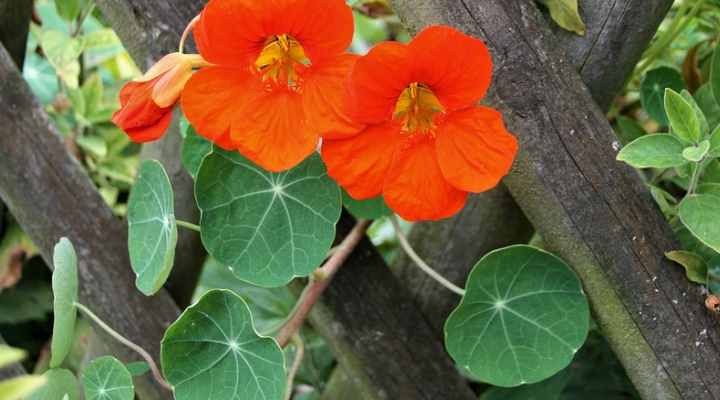
Nasturtiums are one of the fastest-growing flower seeds that grow easily after sprouting. These easy-going, vibrant trumpet-like flowers grow on creeping or sprawling stems contrasting with green parasol-like leaves. Depending on the cultivar, nasturtiums can bloom in orange, yellow, and red shades. They spread or climb up to 10 ft. (3 m).
Nasturtiums are easy-to-grow flowers that bloom about four to eight weeks after germinating. You can enjoy their showy flowers from spring through summer until fall. The popular annuals are ideal for growing as full sun ground cover, garden edgings, or borders. Climbing nasturtiums cover fences and trellises up to 10 ft. (3 m) tall. Nasturtium flowers are edible and have a peppery and slightly spicy flavor, making them a popular choice for adding color and a hint of spice to salads, garnishes, and various dishes.
- Days to Germinate: 7 – 14 days
- Days to Bloom After Sowing: 40 – 60 days
- Seed Sowing Soil Temperature: 55°F to 65°F (12°C – 28°C)
- Sow method: Directly sow in the ground in late spring after the last frost, or start seeds indoors 2 to 4 weeks before the last frost.
- USDA Zone: 2 to 11
- Light: Full sun to partial shade
- Soil Type: Poor, well-draining soil for best flowering and less foliage
Poppies (Papaver)

Annual poppies are fast-growing flower seeds germinating in as little as seven days. You can expect the red flowers with their papery petals to bloom about 60 days after sowing. Poppy flowers are known for their showy, cup-shaped blossoms on slender stems in red, orange, yellow, and pink colors.
Annual poppies bloom in their first season, from late spring to early summer, creating colorful floral displays. Their bright, showy flowers look spectacular in cottage gardens, borders, and containers. You can extend their bloom time by deadheading spent flowers. Some poppy varieties are biennial or perennial flowers and will return year after year.
- Days to Germinate: 7 – 14 days
- Days to Bloom After Sowing: 40 – 65 days
- Seed Sowing Soil Temperature: 60°F to 70°F (15°C – 21°C)
- Sow method: Directly sow in the ground in early spring by scattering the seeds on the surface before lightly pressing them in.
- USDA Zone: 2 to 10
- Light: Full sun
- Soil Type: Well-draining, fertile soil
Pot Marigold (Calendula officinalis)
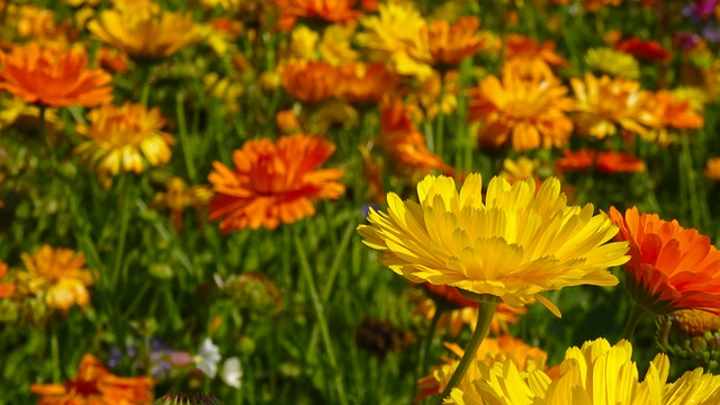
Pot marigolds are easy-growth annual flowers that produce blooms five or six weeks after germinating. The sun-loving flowering plants add vibrant colors to landscapes. The bright, showy yellow or orange daisy-like flowers bloom from spring to fall 1 to 2 ft. (0.3 – 0.6 m) tall.
These beautiful flowers are visually appealing and brighten borders, beds, and containers. Depending on the species, they may have single or double blooms with contrasting darker central disks. The attractive, fast-growing flowers bloom over a long period—almost continually until the first fall frost.
- Days to Germinate: 5 – 12 days
- Days to Bloom After Sowing: 50 – 60 days
- Seed Sowing Soil Temperature: 60 to 70°F (15 – 21°C)
- Sowing Method: Sow directly in the soil just before the last spring frost date. Alternatively, start seeds indoors 6 to 8 weeks before the last frost.
- USDA Zone: 2 to 11
- Light: Full sun to partial shade
- Soil Type: Well-drained, loamy soil with good organic matter content
Zinnias (Zinnia)
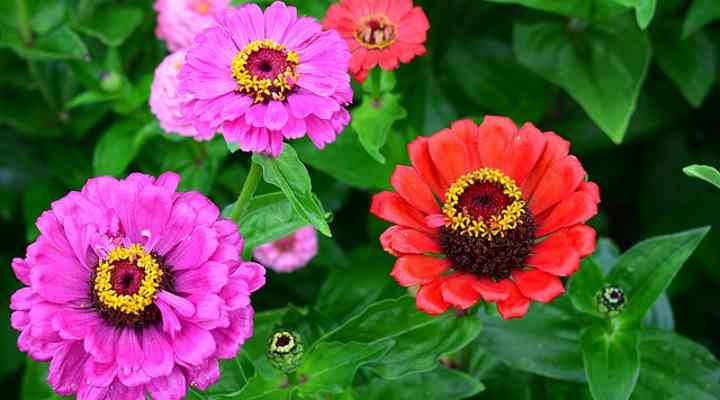
Zinnias are fast-growing annual flower seeds that germinate quickly and bloom as soon as eight weeks after sowing. These vibrant, colorful flowers can have a daisy-like appearance or star shape. The showy blooms come in a wide range of colors, including red, orange, yellow, pink, and purple. The large flowers grow up to 4 ft. (1.2 m) tall.
Zinnias are popular for their long-lasting blooms from late spring through fall. The fragrant flowers attract butterflies and bees to gardens. They are perfect for adding a pop of color to borders, beds, mass plantings, and containers. These low-maintenance flowers are also heat and drought-tolerant, ideal for hot summer climates.
- Days to Germinate: 7 – 10 days
- Days to Bloom After Sowing: 45 – 60 days
- Seed Sowing Soil Temperature: 70°F to 75°F (21°C – 24°C)
- Sow Method: Directly sow the seeds into well-draining soil after the last frost date or start seeds indoors 4 to 6 weeks before the last frost.
- USDA Zone: 2 to 11
- Light: Full sun
- Soil Type: Well-draining soil with average fertility
Sweet Alyssum (Lobularia maritima)
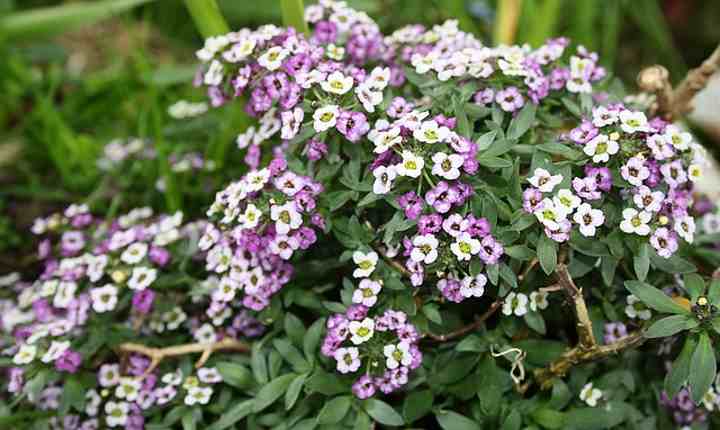
Sweet alyssum is a low-growing annual flower that blooms a few weeks after germination. The mat-forming ground cover plant is known for its clusters of small, fragrant, four-petalled flowers. The annual flowers don’t grow taller than 12” (30 cm) tall and spread by self-seeding.
Sweet alyssum is an easy-to-grow flower and a great addition to rock gardens or as a ground cover in full sun. The annuals bloom for a long time—from late spring until the first frost. The attractive flowers make the plant perfect for adding white, purple, or pink colors to garden landscapes. The drought and heat-tolerant plant has a sweet honey-like fragrance.
- Days to Germinate: 7 – 14 days
- Days to Bloom After Sowing: 30 – 40 days
- Seed Sowing Soil Temperature: 60°F to 70°F (15°C – 21°C)
- Sowing Method: Directly sow the seeds in the ground after the last frost date or start the seeds indoors 6 to 8 weeks before the last frost.
- USDA Zone: 5 to 11
- Light: Full sun to partial shade
- Soil Type: Well-draining, moderately fertile soil
Johnny Jump-Ups (Viola tricolor)

Johnny Jump-Ups flowers grow rapidly from seed and are easy to grow in late spring and summer landscapes. The charming annual fast-grower blooms around eight weeks after germinating. Johnny Jump-Ups are known for their small, delicate, petalled flowers that typically have three vibrant colors. Their long-blooming season extends from spring through fall.
These fast-growing flowers grow as annuals in colder climates. They are perfect for growing in borders, containers, garden edging, and coastal gardens. Blooming in full sun and not growing more than 12” (30 cm) tall, they spread profusely in yards thanks to their self-sowing habit.
- Days to Germinate: 7 – 14 days
- Days to Bloom After Sowing: 40 – 50 days
- Seed Sowing Soil Temperature: 60 to 70°F (15 – 21°C)
- Sowing Method: Sow seeds directly on the soil surface after the threat of frost has passed. Alternatively, sow them in starter trays with moistened soil indoors 6 to 8 weeks before the last frost date.
- USDA Zone: 3 to 9
- Light: Full sun to partial shade
- Soil Type: Well-draining, moderately fertile soil
Cornflowers (Centaurea cyanus)

Cornflowers are easy-to-grow annual flowers that bloom about 60 days after sowing. Fast-growing cornflowers are known for their vibrant blue, pink, white, or maroon blooms that last from late spring until late summer. They grow in upright clumps up to 3 ft. (1 m) tall and spread 12” (30 cm) wide.
Also known as bachelor’s buttons, cornflowers grow rapidly from seed. These versatile flowers are ideal for landscaping solutions in containers, borders, and cottage gardens. There are also dwarf varieties that are perfect for the front of borders and rock gardens. They are easy to plant in the ground in late spring after frosts have passed.
- Days to Germinate: 7 – 14 days
- Days to Bloom After Sowing: 60 –70 days
- Seed Sowing Soil Temperature: 60°F to 70°F (15°C – 21°C)
- Sow Method: Directly sow in the ground after the last frost date or start the seeds indoors 6 to 8 weeks before the last spring frost date. You can sow the seeds in the fall and lightly rake it over for early spring blooms in mild winter regions.
- USDA Zone: 2 to 11
- Light: Full sun
- Soil Type: Poor, well-draining soil
Sunflowers (Helianthus)
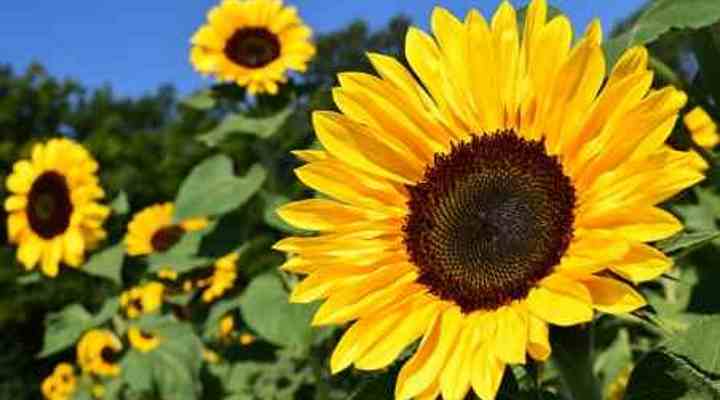
Sunflowers are easy to grow from seed and can be planted directly in the ground or seed boxes to get them started in early spring. The fast-growing flowers have vibrant yellow disk-shaped blooms and tall, sturdy stems. Sunflowers can reach heights of up to 10 feet (3 meters) in just a few months.
Sunflowers are known for their large, daisy-like yellow blooms. Their tall stature makes them ideal for back-of-the-border planting or planting along a fence line. Sunflowers come in various sizes, from small dwarf varieties to giant varieties, with flower heads that can be as large as a dinner plate.
- Days to Germinate: 7 – 14 days
- Days to Bloom After Sowing: 70 – 100 days
- Seed Sowing Soil Temperature: 60°F to 70°F (15.5°C – 21°C)
- Sow method: Directly sow in the ground after the last frost or start seeds indoors four weeks before the last frost date.
- USDA Zone: 2 to 11
- Light: Full sun
- Soil Type: Well-draining, moderately fertile, humus-rich soil
Morning Glory (Ipomoea purpurea)
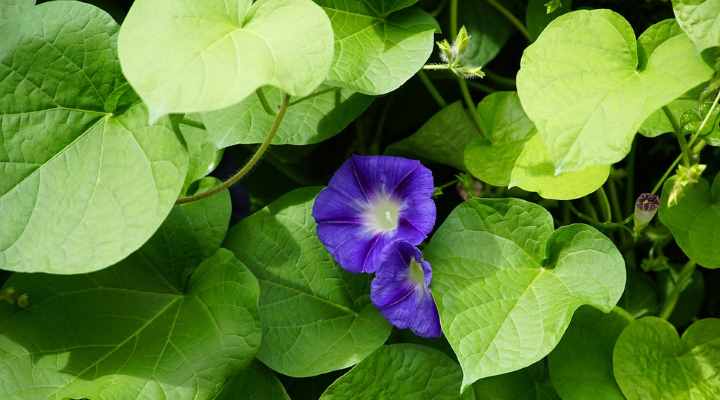
Morning glories are not the fastest-blooming flower seeds, but they produce stunning trumpet-like flowers in early summer. Once planted in the ground, the fast-growing annual vine produces attractive blue and purple flowers that scramble over the ground, covering the soil with purple shades and heart-shaped green foliage. They can spread up to 6 ft. (1.8 m) wide.
Morning glories are versatile blue or purple-flowering vines with twining stems. Climbing a pergola, arbor, or trellis, the flowers add vertical interest to garden landscapes. You can grow the quick-growing trailing plant in hanging baskets or cascade over a wall or unsightly fence. The attractive purple-blue flowers bloom continuously from summer through fall.
- Days to Germinate: 5 – 10 days
- Days to Bloom After Sowing: 60 – 120 days
- Seed Sowing Soil Temperature: 70°F to 85°F (21°C – 29°C)
- Sow method: Directly sow in the ground after the last frost date, as morning glories do not transplant well. Soak the seeds in water overnight before planting to help with germination.
- USDA Zone: 2 to 11
- Light: Full sun
- Soil Type: Well-draining, moderately fertile soil
Spider Flower (Cleome hassleriana)

Spider flowers are fast-growing annual flowers that bloom about 60 to 80 days after sowing. These unique annual flowers feature clusters of pink, purple, or white blossoms with long, spindly stamens resembling spider legs. The attractive flowers grow up to 5 ft. (1.5 m) tall.
These fast-blooming flowers bloom for a long time, from early summer until the first frost. The tall flowers look stunning in borders, butterfly gardens, and containers. Some smaller varieties are also excellent for compact gardens when growing in groups as eye-catching annuals.
- Days to Germinate: 7 – 14 days
- Days to Bloom After Sowing: 60 – 80 days
- Seed Sowing Soil Temperature: 60°F to 65°F (15.5°C – 18°C) during the night and 75°F to 80°F (24°C – 26°C) during the day
- Sowing Method: Sow seeds directly in the ground after the last frost date or start seeds indoors 6 to 8 weeks before the last frost.
- USDA Zone: 2 to 11
- Light: Full sun to partial shade
- Soil Type: Well-draining, average fertile soil
Love-in-a-Mist (Nigella damascena)
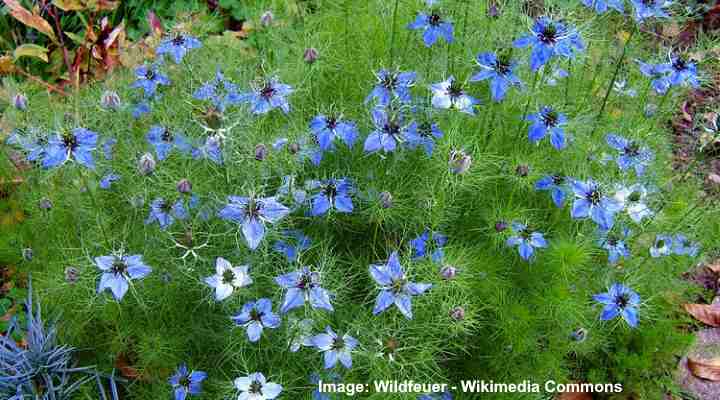
Love-in-a-mist is a fast-growing annual flower with seeds that germinate in less than a week. After planting the seedlings, the flowers bloom twelve weeks after transplanting. Also called nigella, the blue or white flowers feature jewel-like blooms surrounded by intricate, lacy foliage. The small annual grows up to 24” (60 cm) tall.
These charming blue flowers are a perfect addition to mixed beds, cottage gardens, and containers. The pretty blossoms bloom throughout summer, giving way to ornamental seed pods in the fall. You can plant the fast-growing seeds in the fall if they have winter protection.
- Days to Germinate: 7 – 14 days
- Days to Bloom After Sowing: 60 – 90 days
- Seed Sowing Soil Temperature: 60°F to 70°F (15°C – 21°C)
- Sow method: Directly sow in the ground in early spring by putting the seeds 0.125” (3 mm) under the soil surface. The seedlings don’t transplant well.
- USDA Zone: 2 to 11
- Light: Full sun
- Soil Type: Well-draining, fertile soil with medium moisture
Annual Phlox (Phlox drummondii)
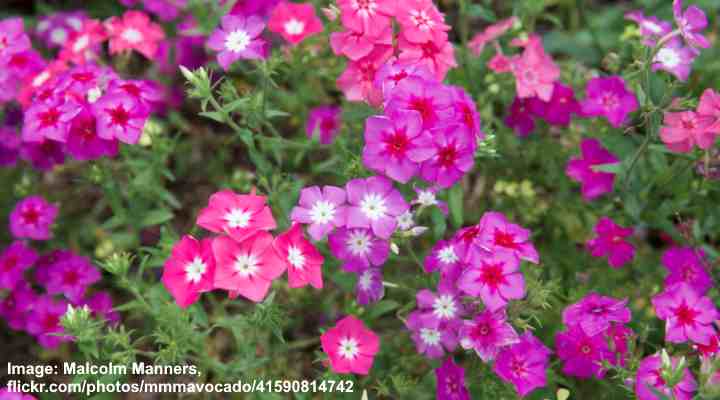
Low-growing annual phlox is easy to grow from seed and blooms four or five weeks after germinating. The fast-growing funnel-shaped flowers bloom in rosy red, pink, or white shades throughout the summer. Growing less than a foot tall (30 cm), annual phlox creates fragrant floral displays without much effort.
Annual phlox is a popular choice for sunny gardens for attracting butterflies, hummingbirds, and bees. The trumpet-like flowers and dark green foliage are a great addition to rock gardens, foundation plantings, or containers on patios. You can also grow the sprawling plant as ground cover.
- Days to Germinate: 7 – 30 days
- Days to Bloom After Sowing: 60 – 70 days
- Seed Sowing Soil Temperature: 60 to 70°F (15 – 21°C)
- Sowing Method: Sow seeds directly in the ground after the last frost because the plants don’t transplant well. Or start seeds indoors 6 to 8 weeks before the frost date in individual peat pots. Then, plant the individual pots in the ground after the risk of frost has passed.
- USDA Zone: 2 to 11
- Light: Full sun to partial shade
- Soil Type: Fertile, medium moisture soil that drains well
Cosmos (Cosmos atrosanguineus and Cosmos bipinnatus)

Cosmos flowers are fast-growing annuals that go from seed to bloom in several weeks. The daisy-like papery flowers sit on slender stems, creating a swaying sea of pink, white, lavender, and red color. Cosmos flowers grow up to 6 ft. (1.8 m) tall and have feathery foliage that adds texture to garden beds and borders.
Cosmos flowers are some of the easiest fast-growing annuals with long-lasting blooms for low-maintenance gardens. They bloom for several months—from early summer to fall. They create a stunning, colorful impact in front and backyards. They are also drought-tolerant and can withstand hot summer temperatures.
- Days to Germinate: 7 – 21 days
- Days to Bloom After Sowing: 60 – 90 days
- Seed Sowing Soil Temperature: 75°F (24°C)
- Sowing Method: Sow seeds directly in the garden 0.25” (6 mm) under the soil surface after the last frost or start seeds indoors 4 to 6 weeks before the last frost.
- USDA Zone: 2 to 11
- Light: Full sun to partial shade
- Soil Type: Average, moist, well-draining soil
Marigolds (Tagetes)

Marigolds are fast-growing annual flowers that typically bloom six to eight weeks after germinating. Therefore, seeds sown in early April should bloom in May. These vibrant flowers are known for their large, showy double blooms and aromatic foliage with deeply divided lanceolate leaves. The eye-catching flowers bloom on erect stems in orange, creamy-white, yellow, and red shades.
Marigolds are easy flowers to grow from seed and can be planted in sunny spots in your garden. Common landscape uses for marigolds included bedding, edging, or foundation planting. They also perform well in containers as patio plants. Deadheading spent blooms encourages continuous blooming from summer through fall.
- Days to Germinate: 4 –7 days
- Days to Bloom After Sowing: 45 – 50 days
- Seed Sowing Soil Temperature: 70°F to 75°F (21°C – 24°C)
- Sowing Method: Sow seeds 0.20” (5 mm) in the ground 8” (20 cm) apart after the last frost or start seeds indoors 4 to 6 weeks before the last frost.
- USDA Zone: 2 to 11
- Light: Full sun
- Soil Type: Moderately fertile, well-draining soil
Globe Amaranth (Gomphrena)
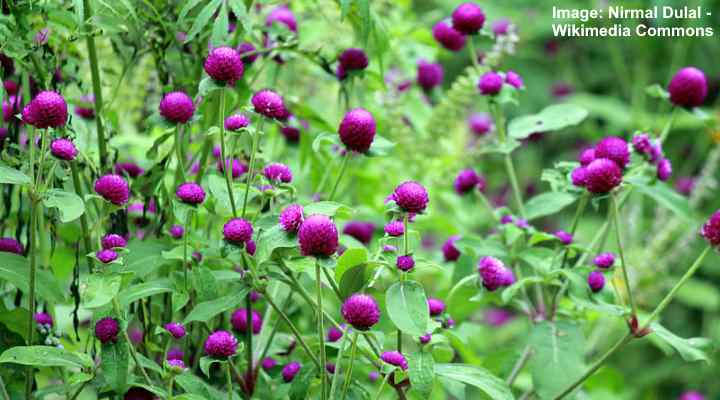
Globe amaranth is easy to grow and produces incredibly showy blooms a few weeks after germinating. This fast-growing annual flower is identified by its small, rounded flowerheads blooming in purple, pink, white, red, and orange colors. The long-lasting globe-like flowers are perfect for dried flower arrangements.
Globe amaranth flowers are low-maintenance and have a bushy, upright habit. They grow 6” to 30” (15 – 74 cm) tall and wide. These popular annuals are ideal for quickly adding color to beds and borders, cottage gardens, and pollinator gardens. Additionally, they perform well in containers to grow on a patio, decking area, or balcony.
- Days to Germinate: 7 – 14 days
- Days to Bloom After Sowing: 40 – 60 days
- Seed Sowing Soil Temperature: 65°F to 75°F (18°C – 24°C)
- Sow method: Sow seeds directly in the ground after the last frost date or start seeds indoors 6 to 8 weeks before the last frost.
- USDA Zone: 2 to 11
- Light: Full sun
- Soil Type: Drought tolerant in well-drained, moderately fertile soil
California Poppy (Eschscholzia californica)

California poppies are incredibly easy-to-grow annual flowers germinating about 14 to 20 days after sowing. You can expect showy orange flowers to appear around six weeks after germinating. The fast-growing poppies are known for their bright orange, yellow, and red cup-shaped flowers, and blue-green lacy foliage.
California poppies are hardy, low-maintenance landscaping flowers, perfect for adding a pop of vibrant color to gardens. They look beautiful in beds and borders, rock gardens, or edging along pathways. You can grow the flowering annuals in a single season in containers to add color and texture to a container garden or patio.
- Days to Germinate: 14 – 20 days
- Days to Bloom After Sowing: 60 – 90 days
- Seed Sowing Soil Temperature: 60°F to 65°F (16°C – 18°C)
- Sow method: Directly sow seeds in the ground 0.11” (3 mm) deep in early spring when light frost is still possible. Alternatively, you can plant the seeds directly in the ground in the fall before the first frost.
- USDA Zone: 8 to 10
- Light: Full sun
- Soil Type: Well-drained, poor to average soil
Sweet Pea (Lathyrus odoratus)
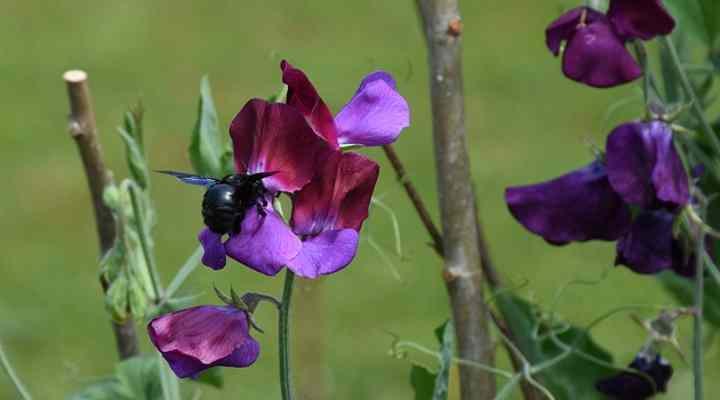
Sweet peas are renowned for their rapid sprouting, with a germination time of as little as seven days. These fast-growing annual vines bloom typically from spring to early fall. They have fragrant, butterfly-like flowers in a variety of colors, including captivating shades of pink, purple, white, and various hues of blue.
Sweet peas can reach heights of 6 to 8 ft. (1.8 – 2.4 m) in a single season. The climbing vine attaches to trellises with stem tendrils that hook around the structure. These beautiful flowers also thrive in containers, create striking displays in borders, and elegantly twine on arbors and arches.
- Days to Germinate: Typically 7 to 14 days
- Days to Bloom After Sowing: Approximately 8 to 12 weeks after sowing
- Seed Sowing Soil Temperature: Sow in soil with a temperature of 50°F to 60°F (10°C to 15°C)
- Sow Method: Directly in the ground or in pots. Plant the seeds about 1 inch deep
- USDA Zone: 3 to 11, depending on the variety
- Light: Full sun to partial shade. They thrive in bright, sunny locations
- Soil Type: Well-drained, fertile soil with good organic matter is ideal for Sweet Peas. They appreciate slightly alkaline to neutral pH levels in the soil
What is the Easiest and Fastest Flower to Grow?
Marigolds, zinnias, sunflowers, cosmos, nasturtiums, morning glories, poppies, and bachelor’s buttons are among the easiest and fastest flowers to grow from seed. They offer a burst of color and beauty in gardens. Plant them directly in the soil or in containers, and with proper care, they’ll quickly reward you with vibrant blooms. Factors like soil quality, watering, and sunlight play a role, so follow seed packet instructions for best results.
Related articles:
